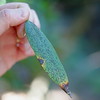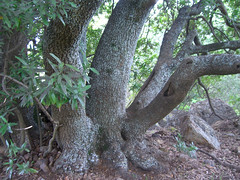

From Science Daily:
The native plants unique to California are so vulnerable to global climate change that two-thirds of these "endemics" could suffer more than an 80 percent reduction in geographic range by the end of the century, according to a new University of California, Berkeley, study.Because endemic species -- native species not found outside the state -- make up nearly half of all California's native plants, a changing climate will have a major impact on the state's unparalleled plant diversity, the researchers warn.
(There's much more at that link.)
The illustration they use for this story is a range map for the California Bay tree, Umbellaria californica, one of those trees of my childhood about which I get emotional. I was delighted when Botany Photo of the Day published some of my photos of local bay trees. You can see, in the illustration, how California's island ecology can shape an organism's range. In this case, the deserts of southeast and northeast California and the Sierra Nevada keep the California Bay (which is also called Bay Laurel or Pepperwood in various parts of its range) up against the coast and in the foothills around the valley. That map seems to suggest that with dispersal over the course of climate change (and how would that happen? people?) the range can remain perhaps large, even as range is lost due to change.


In my own head, I've been pondering the future, and whether it makes sense to simply watch some of the endemic organisms of California die off as climate changes, being as it's so much harder for anything to adapt than it used to be -- where will they go? we've fragmented habitat such that animals and annual plants can't move as they used to, and trees shift range slowly even in good circumstances -- or whether they should have human help, being as they'd mostly be displacing or joining organisms who will also need to move as their own climates change. Does it make sense to help move California bay, redwood, douglas iris, valley oaks, and other California-adapted organisms into more hospitable locations for them? Will failing to do so decrease biodiversity across the ranges of what lives in California and Oregon now? What's happening now will affect biodiversity in both areas anyway. The lands north of us will either lose or need to help move its endemic life. Regardless, the richness will become less rich.




No comments:
Post a Comment